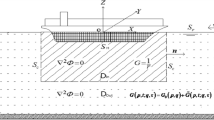Abstract
In this article, electromagnetic control of a turbulent boundary layer (TBL) on a ship hull, without free surface effects, is numerically investigated. This study is conducted on the KVLCC2M ship model hull. For this purpose, a combination of electric and magnetic fields is applied to a region of the boundary layer on the stern to produce wall-parallel Lorentz forces in streamwise direction as body forces in a ship’s stern flow. The governing equation including RANS equations with shear-stress transport (SST) k−ω turbulent model coupled with electric potential equation is numerically solved by using Ansys Fluent codes. Before using for ship’s flow, Fluent electric potential code is validated by simulating magneto-hydro-dynamics (MHD) flow in a rectangular duct and comparing obtained numerical solutions with exact solutions. Accuracy of SST k−ω turbulent model in predicting turbulent flow around a ship is also tested by comparing with available experimental data. The results obtained for ship flow show that by applying streamwise Lorentz forces, flow is accelerated. The results are caused to delay or avoid the flow separation in stern and make uniform flow distribution behind the ship’s hull. It is caused to improve the propeller performance and diminish the total resistance.






















Similar content being viewed by others
References
Ritchie W (1832) Experimental researches in voltaic electricity and electromagnetism. Phil Trans Roy Soc Lond 122:279–298
Rice W (1961) Propulsion system, US Patent 2997013
Friauf J (1961) Electromagnetic ship propulsion, ASNE J, pp. 139–142
Way S (1967) Electromagnetic propulsion for cargo submarines, AIAA, pp. 1967–0363
Gailitis A, Lielausis O (1961) On a possibility to reduce the hydrodynamic resistance of a plate in an electrolyte. Appl Magnetohydrodyn Rep Phys Inst 12:143–146
Henoch C, Stace J (1995) Experimental investigation of a salt water turbulent boundary layer modified by an applied streamwise magnetohydrodynamic body force. Phys Fluids 7:1371–1383
Weier T, Fey U, Gerbeth G, Mutschke G, Lielausis O, Platacis E (2001) Boundary layer control by means of wall parallel Lorentz forces. Magnetohydrodynamics 37:177–186
Crawford C, Karniadakis G (1997) Reynolds stress analysis of EMHD-controlled wall turbulence: part I streamwise forcing. Phys Fluids 9:788–806
Shtern A (1970) Feasibility of modifying the boundary layer by crossed electric and magnetic fields. Magnetohydrodynamics 6:407–411
Nosenchuck D, Brown G (1993) Discrete spatial control of wall shear stress in a turbulent boundary layer. In: So R, Speziale C, Launder B (eds) Near-wall turbulent flows. Elsevier, Amsterdam
O’Sullivan P, Biringen S (1998) Direct numerical simulations of low Reynolds number turbulent channel flow with EMHD control. Phys Fluids 10:1169–1181
Thibault JP, Rossi L (2003) Electromagnetic flow control: characteristic numbers and flow regimes of a wall-normal actuator. J Phys D Appl Phys 36:2559–2568
Nosenchuck D, Brown G, Culver H, Eng T, Huang I (1995) Spatial and temporal characteristics of boundary layers controlled with the Lorentz force. In: 12th Australian Fluid Mechanics Conference, Sydney
Nosenchuck D (1996) Boundary layer control using the Lorentz force on an axisymmetric body. Bull Am Phys Soc 41:1719
Berger TW, Kim J, Lee C, Lim J (2000) Turbulent boundary layer control utilizing the Lorentz force. Phys Fluids 12:631–649
Du Y, Symeonidis V, Karniadakis G (2002) Drag reduction in wall-bounded turbulence via a transverse travelling wave. J Fluid Mech 457:1–34
Pang J, Choi KS (2004) Turbulent drag reduction by Lorentz force oscillation. Phys Fluids 16:L35–L38
Breuer K, Park J, Henoch C (2004) Actuation and control of a turbulent channel flow using Lorentz forces. Phys Fluids 16:897–907
Crausse E, Cachon P (1954) Actions ´electromagn´etiques sur les liquides en mouvement, notamment dans la couche limited’ obstacles immerg´es,” Comptes rendus hebdomadaires des s´eances de l’ Acad´emie des Sciences 238: pp. 2488–2490
Lielausis O (1961) Effect of electromagnetic forces on the flow of liquid metals and electrolytes. PhD thesis, Academy of Sciences of the Latvian SSR, Institute of Physics, Riga
Lielausis O, Gailitis A, Dukure R (1991) Boundary layer control by means of electromagnetic forces. In: Proc Int Conf on Energy Transfer in Magnetohydrodynamic
Petit JP (1983) Is supersonic flight, without shock wave, possible? In: Proceedings of the 8th International Conference on MHD Electrical Power Generation, Moscow
Weier T, Gerbeth G, Mutschke G, Platacis E, Lielausis O (1998) Experiments on cylinder wake stabilization in an electrolyte solution by means of electromagnetic forces localized on the cylinder surface. Exp Therm Fluid Sci 16:84–91
Kim S, Lee C (2000) Investigation of the flow around a circular cylinder under the influence of an electromagnetic force. Exp Fluids 28:252–260
Posdziech O, Grundmann R (2001) Electromagnetic control of seawater flow around circular cylinders. Eur J Mech B Fluids 20:255–274
Chen Z, Aubry N (2005) Active control of cylinder wake. Comm Nonlin Sci Num Sim 10:205–216
Shatrov V, Yakovlev V (1985) Hydrodynamic drag of a ball containing a conduction-type source of electromagnetic fields. J Appl Mech Tech Phys 26:19–24
Shatrov V, Yakovlev V (1990) The possibility of reducing hydrodynamic resistance through magnetohydrodynamic streaming of a sphere. Magnetohydrodynamics 26:114–119
Hino T (2005) CFD Workshop Tokyo 2005, NMRI, Tokyo
Ansys Fluent Theory Guide (2011), Release 14.5, November
Menter FR (1994) Two-equation eddy-viscosity turbulence models for engineering applications. AIAA J 32(8):1598–1605
Schercliff JA (1953) Steady motion of conducting fluids in pipes under transverse magnetic fields. Proc Camb Phil Soc 49:126–144
Hunt JCR (1965) Magnetohydrodynamic flow in rectangular ducts. J Fluid Mech 21:577–590
Acknowledgments
This research was supported by High Performance Computing Research Center (HPCRC) at Amirkabir University of Technology, which is acknowledged. The authors wish to thank the reviewers for their valuable comments and suggestions.
Author information
Authors and Affiliations
Corresponding author
Additional information
Technical Editor: Francisco Ricardo Cunha.
Rights and permissions
About this article
Cite this article
Bakhtiari, M., Ghassemi, H. Controlling of the boundary layer flow on a ship hull using MHD. J Braz. Soc. Mech. Sci. Eng. 37, 479–493 (2015). https://doi.org/10.1007/s40430-014-0178-3
Received:
Accepted:
Published:
Issue Date:
DOI: https://doi.org/10.1007/s40430-014-0178-3




